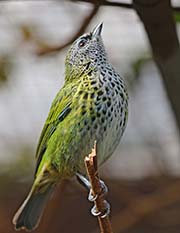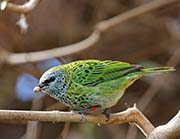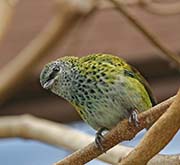Spotted Tanager - Tangara punctata
| Length | |
| Weight | |
| Clutch Size | |
| Chicks at birth | |
| IUCN Conservation Status | |
Continents: |
There are five subspecies of Spotted Tanager is a South American. Their body is made up of various shades of green, lighter around the face and belly, with black spots over much of the plumage. The bill is black, legs and feet gray. Both species look similar but the females are duller in color.
They are found singly or in small groups (2-4) and will sometimes travel with other tanagers canopy species. It was reported that they will perch in the open sometimes to rest and preen.
Diet: Spotted Tanagers mostly feed in the canopy of trees and eat fruit, seeds, berries and some insects.
Courtship: No information found.
Nesting: Spotted Tanagers build small cup nests in trees. 2-4 brown-blotched white eggs are laid.
Habitat and Range: The Spotted Tanager is found in Bolivia, Brazil, Ecuador, French Guiana, Guyana, Peru, Suriname, and Venezuela. They inhabit subtropical or tropical moist lowland forests and subtropical or tropical moist montane forests.
Vocalization: Produces a high-pitched 'chip' in a rapidly repeated staccato manner, then shifts into an evenly pitched, chipping 'trill'.
Plumage/Molt: No alternate plumage, probably molts annually like other tanagers.
Migration: Not migratory.
Tongue/feet: The legs and feet are gray.
Bibliography:
- http://en.wikipedia.org The Free Encyclopedia, Accessed June, 2013
- Isler, Morton L. and Isler, Phyllis R., The Tanagers: Natural History, distribution, and Identification,Smithsonian Institution Press, Washington D.C., 1987
- http://www.avianweb.com/ Avian Web, Accessed June, 2013





